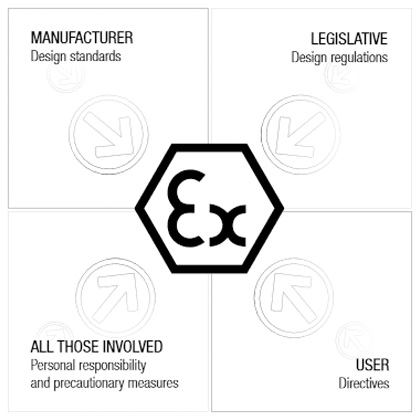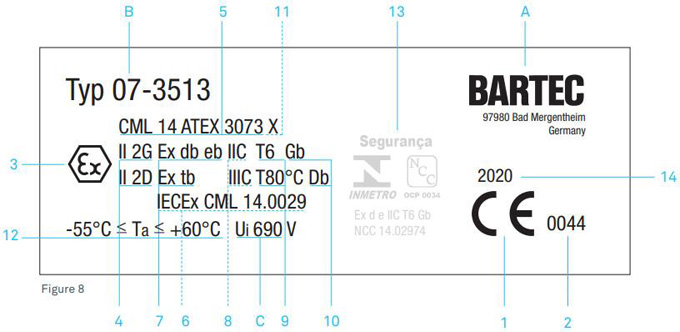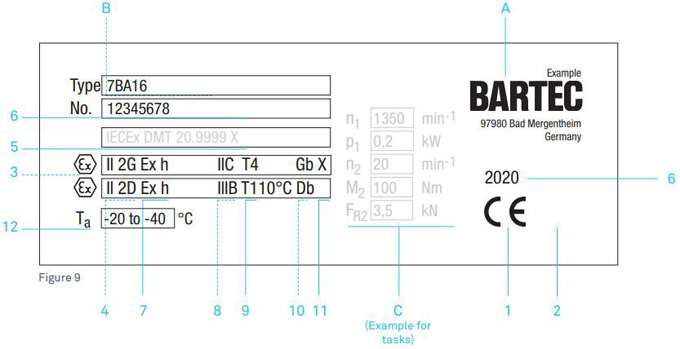Glossary
Technical development of explosion protection

Unwanted ignitions are older than mankind. Atmospheric discharges – lightning – triggered fires long before humans walked the earth. In 1753, the first lightning conductor was invented, enabling electrostatic discharges as the sources of ignition for fires to be significantly reduced. Lamps in mining also constituted another high fire risk for many years, because mine air mixed with methane – so-called firedamp – was able to cause explosions when sufficiently strong ignition sources were present. In 1815, Sir Humphry Davy introduced the first mine safety lamp, a non-electrical item of equipment for mining. Two wire glass screens arranged on top of each other separated the flame - which was to be kept as small as possible inside the screen - from the flammable mixture present, while allowing combustion inside the screen. When used correctly, the screens prevented an external ignition.
In the 19th century, electrical equipment was introduced into industry and households. Immediately afterwards, the occurrence of methane and coal dust in hard coal mining prompted the development of the basics of electrical explosion protection. The advantages of electricity were so convincing that intensive work was carried out to find a way to reliably prevent contact between an explosive atmosphere and ignition sources - originating from the use of electrical equipment - and thus prevent explosions.
After bitter experiences in the beginning, the occurrence of firedamp explosions was greatly reduced and well-monitored electrical equipment was utilised with very high safety standards.
Today, fortunately, the number of accidents caused by electrical ignition sources is low. The expenditure on development and manufacturing and the statutory regulations have proven to be successful and the frequently posed question as to “whether such expenditures are justified“ must be answered with yes. Any neglect is comparable to culpable carelessness. Unfortunately, there are still numerous examples of explosions that demonstrate the devastating effects on humans, environment and plants.
Priority is given to what is regarded as primary explosion protection, for example the focussing of attention on the use of non-flammable substances that are not capable of forming an explosive atmosphere.
However, it is not always possible to exclude flammable substances such as methane or coal dust in mines, or petrol and in future perhaps hydrogen in vehicles. In such cases, protection and safety are provided by equipment, which is reliably explosion proof. Such solution, by providing type(s) of protection is referred to as secondary explosion protection.
These days, the construction of explosion proof equipment goes far beyond the field of electrical engineering. As will be demonstrated in the further descriptions, non-electrical equipment will also require testing or at least assessment. Here the knowledge gained by manufacturers over the decades on the explosion proof electrical equipment is particularly important and it now also benefits the manufacturers of non-electrical equipment.
There are many applications, which require explosion proof equipment. During the over 100 years of electrical explosion protection, principles and techniques have been developed which allow the use of electrical measuring technology, even where, for example in reaction vessels, an explosive atmosphere is permanently present.
The applications in the mining area were the beginning. The utilisation and processing of mineral oil and natural gas offer a wide scope for using explosion proof equipment. Organic chemistry, the paint industry and the pharmaceutical industry all process flammable liquids and gases. Because of the production and utilisation of biogas and the ecological utilisation of waste dumps, new applications are constantly developing. The utilisation of hydrogen is being discussed in depth, practised in experimental installations and will be in our lives as renewable energy.
Relevance and advantage of the area classification in workplaces
The practice has been established of dividing potentially explosive atmospheres into zones. This classification takes the different dangers from explosive atmospheres into account and allows explosion protection measures to be taken, which reflect the situation both from the point of view of safety engineering and of economic efficiency. For the European community, the zone definitions are uniformly provided in Directive 1999/92/EC. It must be applied with technical understanding of the specific situation.
Classification of hazardous areas
Gases, vapours
Zone 0
area in which an explosive atmosphere consisting of a mixture with air of flammable substances in the form of gas, vapour or mist is present continuously or for long periods or frequently
Zone 1
area in which an explosive atmosphere consisting of a mixture with air of flammable substances in the form of gas, vapour or mist is likely to occur in normal operation occasionally
Zone 2
area in which an explosive atmosphere consisting of a mixture with air of flammable substances in the form of gas, vapour or mist is not likely to occur in normal operation but, if it does occur, will persist for a short period only
Dusts
Zone 20
area in which an explosive atmosphere in the form of a cloud of combustible dust in air is present continuously, or for long periods or frequently
Zone 21
area in which an explosive atmosphere in the form of a cloud of combustible dust in air is likely to occur, occasionally, in normal operation
Zone 22
area in which an explosive atmosphere in the form of a cloud of combustible dust in air is not likely to occur in normal operation but, if it does occur, will persist for a short period only.
IEC 60079-10-1 assumes an approximately similar classification for gases and vapours, which will also apply to facilities constructed in accordance with the US standard NEC 505. IEC 60079-10-2 provides support for the zone classification with dusts and will also apply to facilities constructed in accordance with the US standard NEC 506.
Potentially explosive atmospheres are classified depending on the frequency and duration of the explosive atmosphere. This classification provides the scope of the measures to be taken according to Annex II section A in the Directive 1999/92/EC in conjunction with equipment categories according to Annex I of the Directive 2014/34/EU.
In work places the potentially explosive atmospheres are normally classified at most as Zone 1 or 2 and 21 or 22. Zone 0 and 20 are restricted to very small inaccessible areas in work places or are usually restricted to the inside of technical equipment.
Organizational measures
The requisite preconditions for the safe operation of electrical equipment in potentially explosive atmospheres are created in a joint effort by the manufacturers of explosion protected equipment and the constructors and operators of industrial plants. It is important that the operator of such plants should ensure that their personnel know how the danger of explosions is likely to arise and the measures that are to be taken to prevent it.
The employees should be regularly trained on the contents of the explosion protection document in accordance with the Directive 1999/92/EC (occupational safety regulations) and informed by means of written corporate regulations, which should be regularly updated.
Notes:
- Layers, deposits and heaps of combustible dust shall be considered as any other source, which can form an explosive atmosphere.
- ‘Normal operation’ means the situation when installations are used within their design parameters
- The definitions for explosive atmospheres comply with the European directives and EN-IEC standards:
Explosive atmosphere: this is a mixture of air and flammable substances in the form of gases, vapours, mists or dusts under atmospheric conditions in which, after ignition has occurred, combustion spreads to the entire unburned mixture.
Hazardous explosive atmosphere: this is an explosive atmosphere that causes damage on explosion, and which necessitates the introduction of measures to protect employees from explosion hazards.
Explosion Parameters
Examples of the assignment of gases and vapours to the respective temperature classes and explosion sub-groups:

Ignition temperature from dusts (layer and cloud)
For different types of dust, the method for determining the ignition temperature has been unified, and coded in document EN-ISO/IEC 80079-20-2. Please note that dust in its deposited form (layer) has a different ignition (read: smouldering) temperature than in its stirred form (cloud).
The permissible surface temperature for those parts of systems and equipment is determined by subtracting 75 K (Tmax = T5 mm - 75 K) from the smouldering temperature value determined for the 5 mm dust layer and by taking 2/3 (Tmax, = 2/3TCloud) of the ignition temperature value determined for the dust cloud.
The permissible surface temperature of the equipment shall always be smaller than the lowest outcome of the Tmax. values determined by using above mentioned formulas. Temperature classes are not defined for dust, so a concrete type of dust must always be considered. The parameters are made available in comprehensive tables, laboratories determine the values on request, and a small, non-official overview is contained in the downloadable brochure ‘basic concepts’ (edition 14).
Equipment sub-groups for combustible Dusts
From the point of view of electrical engineering, it is not possible to classify dust as precisely as the chemically defined gases and vapours. For that reason, it is considered sufficient to divide the dust according to type and conductivity. EN-ISO/IEC 80079-20-2 contains the test method to determine the specific electrical resistance of dust. Dust is divided into 3 sub-groups:
- IIIA - combustible flyings
- IIIB - non-conductive combustible dust, specific electrical resistance > 10³ Ω • m
- IIIC - conductive combustible dust, specific electrical resistance ≤ 10³ Ω • m
Protection Principles
Protection principles are defined to prevent equipment and components becoming ignition sources.
The protection principles can be applied to electrical and non-electrical equipment and for gases and dusts. The principles allow for a design in various safety categories in accordance with the Directive 2014/34/EU or the Equipment Protection Level (EPL) according to EN- IEC 60079-0 series:
Equipment category 1
very high level of protection and thus a very high degree of safety
Equipment category 2
high level of protection and therefore a high degree of safety
Equipment category 3
normal level of protection and therefore a conventional degree of safety
Equipment Level of Protection a
very high level of protection and thus a very high degree of safety
Equipment Level of Protection b
high level of protection and therefore a high degree of safety
Equipment Level of Protection c
normal level of protection and therefore a conventional degree of safety
Ignition sources which are caused by sparks from friction or impact or from electro-static charging have to be prevented in explosion protected equipment by selecting appropriate materials and by constructive measures, and this must be verified and confirmed by appropriate tests. Four protection principles can prevent equipment from becoming an ignition source.
An important precondition for all the protection principles is that parts which are in unhindered contact with the explosive atmosphere must not be able to reach non-permitted temperatures with respect to the ignition temperature of substances present in the site of installation. This means that the ignition temperature is relevant for all protection principles.
Explosive mixtures can enter the equipment in which an ignition source may be located and be ignited. The transmission of internal ignition to the surrounding atmosphere shall be excluded.
Examples of types of protection:
- Flameproof enclosures (Ex d) - electrical and non-electrical equipment
- Powder (quartz) filling (Ex q) - electrical equipment
The operating equipment has an enclosure, which prevents the penetration of the explosive mixture and/or contact with the internal function-related potential sources of ignition. Examples of types of protection:
- Pressurized enclosures (Ex p) - electrical and non-electrical equipment
- Protection by enclosures (Ex t) - electrical equipment
- Liquid immersion (Ex o) - electrical equipment
- Liquid immersion (Ex h (previous k)) - non-electrical equipment
- Encapsulation (Ex m) - electrical equipment
Explosive mixtures can penetrate the enclosure of the operating equipment but is not allowed to be ignited. Any spark is prohibited and temperatures capable of causing ignitions shall be prevented. Examples of types of protection:
- Increased Safe equipment (Ex e) - electrical equipment
- Non-sparking equipment (Ex nA) - electrical equipment
- Protection by constructional safety (Ex h (previous c)) - non-electrical equipment
Explosive mixtures can penetrate the enclosure of the operating equipment but can’t be ignited. The occurrence of spark energy and increased temperatures shall be limited. Examples of types of protection:
- Intrinsically safe (Ex i) - electrical equipment
- Protection by control of ignition source (Ex h (previous b)) - non-electrical equipment
Types of Protection
It applies to all types of protection where parts that are in unhindered contact with the explosive atmosphere, are not permitted to reach unacceptably high temperatures. Taking into account both the environmental temperature and the heating effect, the temperature may attain maximum values, which corresponds to the temperature class or the permissible temperature specified for flammable dusts in accordance with which the explosive atmosphere has been classified.


Marking
2 Marking examples in accordance with directive 2014/34/EU according to EN 60079 series and IECEx System according to IEC60079 series
Electrical equipment

General manufacturer information
A. Manufacturer name and address
B. Type number of the product
C. Other relevant information for industrial equipment
Information specific to explosion protection (marking)
- Conformity mark (CE)
- Identification number of the Notified Body which - where required - certified the QA system or examined the products (Category 1 and 2)
- Ex mark (community Epsilon x logo)
- Equipment group II - other areas (non-mining) Equipment category 2 either - gases/vapours G, suitable for Zones 1 and 2 or - dusts D, suitable for Zones 21 and 22
- EU-Type Examination Certificate Notified Body name or symbol, year and Notified Body’s certificate registration number
- IEC-Ex Certificate of Conformity (CoC) Certification Body’s symbol, year and Certification Body’s certificate registration number
- Explosion protection in compliance with EN 60079 series, Type of protection: flameproof enclosure and increased safety (gas) - marked Ex d and Ex e, protection by enclosure (dust) - marked Ex t all types of protection having high level of protection b
Explosion protection in compliance with IEC 60079 series, Type of protection: flameproof enclosure and increased safety (gas) - marked Ex d and Ex e, protection by enclosure (dust) - marked Ex t all types of protection having high level of protection b - Group IIC (most easy ignitable gases), Group IIIC (conductive dusts)
- Temperature class T6 (gas), max. surface temperature T80°C in absolute value (dust)
- Equipment protection level Gb (high protection level) (gas), equipment protection level Db (high protection level) (dust)
- “X” observe Specific conditions of use: e. g. “the light module must be installed in a way that ensures its mechanical protection from impact energy in accordance with EN IEC 60079-0”
“U” Ex Component which is not intended to be used alone. Conformity is certified when installed into a complete operating equipment. Components don’t have any temperature class - Ambient temperature range
- Marking in accordance with INMETRO (Example)
Non electrical equipment

General manufacturer information
A. Manufacturer name and address
B. Type number of the product
C. Other relevant information for industrial equipment
Information specific to explosion protection (marking)
- Conformity mark (CE)
- Identification number of the Notified Body which - where required - certified the QA system or examined the products * in this particular case not applicable
- Ex mark (community Epsilon x sign)
- Equipment group II - other areas (non-mining) Equipment category 2 either - Gases/vapours G, suitable for Zones 1 and 2 or -Dusts D, suitable for Zones 21 and 22
- EU-Type Examination Certification Notified body’s symbol, year Notified body’s registration number (only with Category 1 or on voluntary basis for Category 2)
- IEC-Ex Certificate of Conformity (CoC) Certification Body’s symbol, year, Certification Body’s certificate registration number (in IEC-Ex Rules of procedure mandatory required for any EPL)
- Explosion protection in compliance with EN ISO 80079-36, -37 standards type of protection: constructional safety - marked Ex h
Explosion protection in compliance with ISO 80079-36, -37 Standards type of protection: constructional safety - marked Ex h - Group IIC (most easy ignitable gases), Group IIIB (non-conductive dusts)
- Temperature class T4 (gas), max. surface temperature T110°C in absolute value (dust)
- Equipment protection level Gb (high protection level) (gas), equipment protection level Db (high protection level) (dust)
- “X” observe Specific conditions of use: e. g. The gearbox is to be installed only in certain position
“U” Ex component which is not intended to be used alone. Conformity is certified when installed into a complete operating equipment. Components don’t have any temperature class - Ambient temperature range